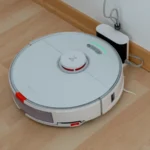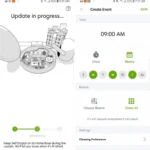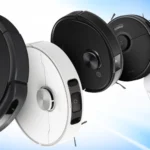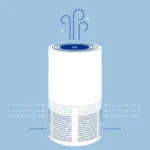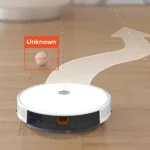When was the last time you thought about the air quality of your indoor environment? Did you know that indoor pollution can be just as harmful, if not more so, than outdoor pollution? Modern technology has given us the ability to combat indoor air pollution in many ways. One option is the use of smart vacuum cleaners equipped with HEPA filters. But what exactly are HEPA filters? And why are they so important in helping improve your indoor air quality? In this article, we’ll break down the benefits of HEPA filters, how to choose the right one for your smart vacuum cleaner, how to maintain it, and other tips for improving your indoor air quality.
What are HEPA Filters?
For many people, vacuuming is an essential household chore that helps maintain a clean and healthy home. However, not all vacuums are created equal, and using the wrong type of vacuum may leave a lot of dirt, dust, and allergens behind. This is where HEPA filters come into play. HEPA stands for High-Efficiency Particulate Air, and these filters are designed to capture even the smallest particles of dust and dirt. In this section, we will dive deeper into what HEPA filters are and why they are a crucial component in keeping your home’s air clean and fresh. If you want to learn more about other factors to consider when choosing a smart vacuum cleaner, check out our comprehensive smart vacuum cleaner guide.
Why are they Important in Smart Vacuum Cleaners?
Studies have shown that the air inside our homes can be dirtier than the air outside. This is due to the accumulation of indoor air pollutants such as dust, pet dander, and allergens. It is crucial to keep the air in our homes clean in order to maintain good indoor air quality, especially for people who suffer from allergies or respiratory problems.
HEPA filters are important in smart vacuum cleaners because they play a significant role in removing these indoor pollutants. These filters work by trapping tiny particles, fine dust, and debris in the air, such as pet hair and pollen, as opposed to pushing them back into the air through the vacuum’s exhaust. As a result, HEPA filters improve the quality of the air in your home during cleaning.
Vacuum cleaners with HEPA filters are especially crucial for pet owners since pet dander and fur are notorious for triggering allergies. By trapping pet hair and dander, HEPA filters help reduce or eliminate the symptoms that come with pet allergies.
Many vacuum cleaners today have smart sensors that detect dust and dirt on the floor and adjust the suction power accordingly. HEPA filters in these smart vacuum cleaners ensure that the air released back into the room is cleaner and healthier to breathe.
For people who use vacuum cleaners frequently or have large homes, the dustbin capacity can be a concern. HEPA filters ensure that the dust and debris is captured by the filter and not in the dustbin which can help avoid frequent emptying of the bin.
HEPA filters are an essential feature in smart vacuum cleaners as they provide a higher level of air purification during cleaning, making them an excellent option for people who want to maintain good indoor air quality.
How do they Improve Indoor Air Quality?
HEPA filters are essential components of smart vacuum cleaners that improve indoor air quality. They work by trapping small particles and pollutants that regular vacuum cleaners would otherwise recirculate into the air. As a result, smart vacuum cleaners with HEPA filters are gaining popularity among homeowners concerned about air quality.
Here are some of the ways in which HEPA filters improve indoor air quality:
- Filtering out micro-particles: HEPA filters trap small particles such as pollen, pet dander, mold spores, and dust mites that can cause allergies and respiratory problems. This is especially beneficial for people with asthma, allergies, or other respiratory conditions. By eliminating these particles, HEPA filters improve air quality and reduce the risk of breathing difficulties.
- Reducing the spread of pathogens: HEPA filters can also capture airborne bacteria and viruses, reducing the risk of illnesses spreading through the air. This is particularly relevant for households with children or elderly individuals who are more susceptible to infections.
- Minimizing unpleasant odors: Smart vacuum cleaners equipped with HEPA filters can also trap unpleasant odors from substances such as pet urine, cigarette smoke, and cooking smells. This not only makes the air easier to breathe but also makes the home smell fresher.
If you live in an area with high levels of pollution or suffer from allergies, HEPA filters can bring tangible benefits to your indoor air quality. However, not all HEPA filters are created equal, and it’s essential to choose the right one for your smart vacuum cleaner.
Continue reading to learn about essential factors to consider when selecting a HEPA filter for your smart vacuum cleaner.
Choosing the Right HEPA Filter for Your Smart Vacuum Cleaner
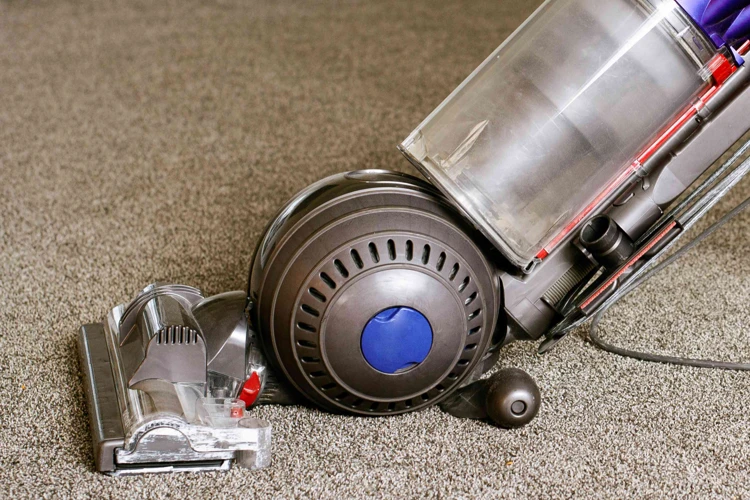
As we’ve previously discussed, HEPA filters play a crucial role in improving indoor air quality while cleaning your home using a smart vacuum cleaner. However, selecting the right HEPA filter can be an overwhelming experience with so many options available on the market today. It’s important to keep in mind a few key factors when choosing a filter that will be the most effective for your needs. Let’s dive into what you need to consider when choosing the right HEPA filter for your smart vacuum cleaner. And if you’re interested in other factors to consider when buying a smart vacuum cleaner, check out our guide on smart home factors to consider.
Filter Efficiency Rating
When it comes to choosing the right HEPA filter for your smart vacuum cleaner, one of the most important factors to consider is the filter efficiency rating. This rating indicates how effectively the filter can remove small particles from your indoor air, such as dust, mold spores, and pet dander. The higher the efficiency rating, the better the filter is at capturing these particles.
Some common filter efficiency ratings you may come across include:
- HEPA-Filtered: These filters are designed to remove at least 99.97% of particles 0.3 microns or larger.
- True HEPA: These filters are similar to HEPA-filtered ones, but are tested and certified to meet higher standards for particle removal.
- HEPA-Type: These filters are not true HEPA filters, but are designed to perform similarly. They typically have a lower efficiency rating than true HEPA filters.
It’s important to note that a filter’s efficiency rating is not the only factor to consider when choosing a filter. Other factors, such as the type of filter material and the filter replacement frequency, can also impact a filter’s performance. However, selecting a filter with a high efficiency rating is a good place to start.
To learn more about other important factors to consider when choosing a smart vacuum cleaner, check out our articles on suction power, battery life, and mapping technology.
Type of Filter Material
When it comes to choosing the right HEPA filter material for your smart vacuum cleaner, there are a variety of options available. Each type is designed to capture certain pollutants and particles in the air, making it important to choose the right one for your specific needs.
Here are the most common types of HEPA filter materials:
- True HEPA: This is the most common type of HEPA filter material and is made of tightly woven glass fibers. True HEPA filters can capture 99.97% of particles as small as 0.3 microns.
- HEPA-Type: This filter is made of a less dense material than true HEPA filters and can capture larger particles in the air. However, they are not as effective at capturing smaller particles as true HEPA filters.
- Activated Carbon: These filters have a layer of activated carbon that is designed to capture odors and chemicals in the air. They are not effective at capturing allergens or dust, but are great for eliminating unpleasant odors.
- Ionizers: These filters are designed to charge particles in the air, causing them to stick to surfaces. However, there is debate over the effectiveness of these filters and their potential negative health effects.
It’s important to note that not all HEPA filters meet the same standards for efficiency. Some filters may be labeled as “HEPA-like” or “HEPA-style,” but do not meet the same efficiency standards as true HEPA filters. Be sure to check the filter’s efficiency rating before making a purchase.
Depending on your needs, you may choose to use a combination of filter materials in your smart vacuum cleaner. For example, if you have pets or allergies, you may want to use a true HEPA filter in combination with an activated carbon filter to eliminate both allergens and odors.
Remember, choosing the right HEPA filter material is an important step in improving the indoor air quality of your home. For more information on selecting the right smart vacuum cleaner, check out our guide to selecting a smart vacuum for pet owners here.
Filter Replacement Frequency
HEPA filters are an essential component of any smart vacuum cleaner, as they trap small particles, dust, mold, and various allergens in the air, making the air cleaner and safer to breathe. It is crucial to choose the right filter for your smart vacuum cleaner and maintain it regularly to ensure optimal performance.
The frequency with which you need to replace your HEPA filter depends on several factors, such as the frequency of use, the size of your home, and the air quality in your area. Typically, your smart vacuum cleaner will alert you to replace the filter either through the app or with a red indicator light on the device.
It is recommended to check the filter replacement frequency when buying a smart vacuum. Some devices have filters that require replacement every two to three months, while others need to be replaced every six to nine months. Regular replacement of the filter is necessary to maintain the air quality in your home and avoid damage to the device’s motor.
To help you better understand the appropriate filter replacement frequency, here is a table that outlines some general guidelines:
| Frequency of Use | Filter Replacement Frequency |
|---|---|
| Heavy use (daily cleaning) | Every 2-3 months |
| Moderate use (2-3 times per week) | Every 6 months |
| Light use (1-2 times per week) | Every 9-12 months |
It’s important to note that these are general guidelines, and the frequency of filter replacement may vary depending on your specific circumstances. However, following these guidelines will help ensure optimal performance and efficient air filtration.
Choosing the right HEPA filter for your smart vacuum cleaner and following the recommended filter replacement frequency will ensure that your device is working efficiently and effectively. Keeping your filter clean will not only extend the life of your device but also improve the air quality in your home. For more information on smart vacuum cleaners, make sure to check out our recent articles on dustbin capacity, smart vacuum noise levels, and smart sensors in smart vacuum cleaners.
Cleaning and Maintaining HEPA Filters

Keeping your smart vacuum cleaner’s HEPA filter clean is essential to ensure it continues to function effectively in improving your home’s indoor air quality. Without proper maintenance and cleaning, the filter can become clogged with dust, reducing its efficiency and preventing it from trapping allergens and other airborne particles. It’s important to understand how to clean and replace your HEPA filter to keep your vacuum working at its optimum level. Let’s delve into some tips for cleaning and maintaining your HEPA filters.
When to Clean/Replace Filters
The maintenance of HEPA filters is crucial to ensure optimal performance of your smart vacuum cleaner, and knowing when to clean or replace the filters is important. Here are some signs that indicate when to clean or replace your HEPA filter:
- Reduced suction power: If you notice that your smart vacuum cleaner is not picking up as much dust and debris as it used to, it could mean that the filter is dirty and needs cleaning or replacing.
- Visible dust on the filter: A dirty filter often accumulates with dust, and if you can see dust particles on the filter, it’s a clear indication that the filter needs cleaning or replacing.
- Unpleasant odors: A dirty filter can cause unpleasant odors to emanate from your smart vacuum cleaner. If you notice such smells, it’s advisable to check the HEPA filter and clean or replace it if needed.
- Increased noise: A clogged HEPA filter can cause your vacuum cleaner to work harder, resulting in increased noise levels. If you notice unusually loud sounds from your vacuum, it could be a sign that the filter needs cleaning or replacing.
- Filter maintenance schedule: It’s recommended to clean or replace your HEPA filter at least once every six months. However, the frequency of filter maintenance may vary depending on usage and the manufacturer’s recommendations. Check your vacuum cleaner’s manual for the recommended maintenance schedule.
Keep in mind that a dirty HEPA filter not only reduces the suction power of your vacuum but also allows the release of allergens and dust back into the air, which is harmful to your indoor air quality. Regularly cleaning or replacing your HEPA filter helps to maintain optimal performance and improves air quality in the home.
How to Clean/Replace Filters
Maintaining and cleaning HEPA filters is essential to keep them working efficiently. These filters trap a large number of pollutants and allergens, thus needing frequent maintenance. Here are some tips on cleaning and replacing HEPA filters:
Cleaning the Filter
Before starting the cleaning process, refer to the vacuum cleaner’s user manual to check how to remove the filter safely. In general, filters are removable and can be easily washed, but some cleaners may require a replacement filter instead.
For washable filters:
1. Disassemble the filter and tap it gently against a hard surface to remove surface-level dirt and dust.
2. Rinse the filter under warm water using a sink or hose.
3. Soak the filter in water to remove any stubborn dirt or stains. For better results, add a few drops of dish soap.
4. Rinse the filter thoroughly and make sure that all soap residue is removed.
5. Squeeze the filter gently to remove any excess water and then leave it to air-dry naturally.
Replacing the Filter
HEPA filters have a specific lifespan, which means replacing them after a certain period is crucial. Most manufacturers recommend replacing filters every 6 to 12 months, depending on usage frequency.
To replace the filter:
1. Check the user manual to determine which filter is compatible with your vacuum cleaner.
2. Remove the old filter by disassembling it carefully.
3. Insert the new filter into the vacuum cleaner’s filter compartment.
4. Reassemble the filter into the vacuum cleaner, ensuring that it is secured tightly.
It is vital to note that replacing the filter is not only beneficial for the vacuum cleaner’s performance but for indoor air quality as well.
Cleaning and Replacing Schedule
Monitoring the filter’s cleanliness and replacement schedule is essential for maintaining the vacuum cleaner’s performance and indoor air quality. Keep a note of the following cleaning and replacement intervals:
Filter cleaning: Monthly or bi-monthly, depending on the usage frequency.
Filter replacement: Every 6 to 12 months or as per the manufacturer’s instructions.
By following these simple tips, you can extend the life of your vacuum cleaner’s HEPA filter and ensure a healthier indoor environment for you and your family.
Additional Tips to Improve Indoor Air Quality
Now that you understand the benefits of HEPA filters in smart vacuum cleaners, it’s important to know that improving indoor air quality is not a task that can be accomplished by simply relying on one tool alone. Hence, to fully optimize your efforts in creating a healthy and clean home environment, consider implementing the following additional tips that are proven to significantly enhance indoor air quality. By combining these tips with HEPA filter technology, you can breathe easy knowing that you are taking proactive steps to reduce harmful air pollutants and allergens in your home.
Vacuuming Techniques
Keeping your home clean and dust-free is important not only for the sake of aesthetics, but for your health as well. Effective vacuuming is an important part of maintaining cleanliness, and using a smart vacuum cleaner with a HEPA filter is a great step towards improving indoor air quality. But it’s not just about using the right vacuum; it’s also about using effective vacuuming techniques.
Here are some tips for effective vacuuming:
| Technique | Description |
|---|---|
| Vacuum regularly | Regular vacuuming can help prevent a buildup of dust and other allergens. Aim to vacuum at least once a week, or more often if needed. |
| Use slow, steady strokes | Rather than rushing through your vacuuming, take your time and use slow, steady strokes. This will allow the vacuum to effectively pick up dirt and dust particles. |
| Overlap strokes | Overlap each stroke slightly to ensure you don’t miss any spots. |
| Use the crevice tool | The crevice tool can be great for getting into tight spaces, such as corners and along baseboards. |
| Vacuum upholstery and curtains | Dust and other allergens can easily accumulate on furniture and curtains, so don’t forget to vacuum them regularly. |
| Adjust the height of your vacuum | Make sure your vacuum is adjusted to the appropriate height for the surface you’re cleaning. Too low and it can be difficult to push, too high and it won’t effectively pick up dirt. |
By incorporating these vacuuming techniques, you can ensure that your smart vacuum cleaner is effectively picking up dirt and dust, ultimately improving the air quality of your home.
Allergen Control
When it comes to indoor air quality, allergy sufferers know all too well how important it is to control allergens. HEPA filters in smart vacuum cleaners can certainly help with this, but there are some additional steps you can take to keep your home as allergen-free as possible.
1. Dusting: Regularly dusting your home with a damp cloth or microfiber duster will help to remove built-up dust and allergens from surfaces. Be sure to focus on surfaces that are easily overlooked, such as blinds, lampshades, and baseboards.
2. Washing Linens: Bedding, curtains, and other linens can trap allergens that can be released into the air when disturbed. Wash these items regularly in hot water to eliminate any allergens that may have accumulated.
3. Controlling Humidity: Mold and dust mites thrive in humid environments, so it’s important to keep indoor humidity levels in check. Use a dehumidifier in areas that tend to be more humid, such as bathrooms and basements.
4. Removing Shoes: Shoes can track in allergens from outdoors, so make it a habit to remove your shoes before entering your home. Keep a shoe rack near the entrance to make this an easy habit to adopt.
5. Vacuuming Furniture: In addition to vacuuming floors, it’s important to vacuum furniture as well. Upholstered furniture can trap allergens and dust, so be sure to use the appropriate attachments on your smart vacuum cleaner to thoroughly clean all surfaces.
By combining the benefits of HEPA filters with these additional allergen control measures, you can create a healthier, more comfortable indoor environment for yourself and your family.
Home Environment
Maintaining a clean home environment is crucial to improve indoor air quality. Here are some tips to keep in mind:
- Avoid smoking indoors: Smoking indoors can release harmful pollutants that can settle into the carpet, furniture, and other surfaces of your home, and will require more heavy-duty cleaning with your smart vacuum cleaner.
- Use eco-friendly cleaning products: Avoid using harsh chemicals or cleaning products that contain volatile organic compounds (VOCs), which can also contribute to poor indoor air quality. Opt for eco-friendly cleaning products instead.
- Use your smart vacuum cleaner regularly: Regular vacuuming can help to remove dust, dirt, and other allergens from your home environment before they have a chance to settle and degrade the air quality.
- Keep windows open: Allowing fresh outdoor air to circulate throughout your home can help to remove indoor pollutants and improve air quality.
- Maintain a healthy humidity level: High humidity levels can create a breeding ground for mold and mildew. Use a dehumidifier if necessary to keep humidity levels between 30-50%.
- Keep pets groomed: Pets can release dander and hair into the air, which can trigger allergies and degrade indoor air quality. Regular grooming can help to minimize the amount of pet hair and dander in your home environment.
By following these tips, along with using a smart vacuum cleaner with a HEPA filter, you can drastically improve the air quality in your home environment and reduce the risk of allergies and other respiratory problems.
Conclusion
In conclusion, it is clear that HEPA filtration technology is a major added benefit in smart vacuum cleaners. By removing microscopic particles from the air, HEPA filters help create a cleaner and healthier living space. The use of a smart vacuum cleaner with a high-quality HEPA filter can significantly improve indoor air quality and reduce the risk of allergies, asthma, and other respiratory illnesses.
However, it is important to choose the right HEPA filter for your smart vacuum cleaner based on factors like filter efficiency rating, type of filter material, and filter replacement frequency. It is also crucial to properly clean and maintain the filter to ensure its efficiency in removing pollutants from the air.
By following the tips and techniques discussed in this article, you can optimize the use of your smart vacuum cleaner with a HEPA filter to improve indoor air quality. Regular vacuuming with allergen control measures and maintaining a clean and healthy home environment can go a long way in ensuring a healthier and happier living space for you and your family.
In short, investing in a smart vacuum cleaner with a HEPA filter can be a valuable addition for anyone looking to improve indoor air quality in their home. With proper maintenance and cleaning, it can help ensure a healthier living environment for you and your loved ones. So, if you haven’t already, consider adding a smart vacuum cleaner with a HEPA filter to your cleaning routine today!
Frequently Asked Questions
1. How often should you replace the HEPA filter in a smart vacuum cleaner?
Generally, it’s recommended to replace the HEPA filter every 6-12 months, depending on usage and the manufacturer’s recommendations.
2. Can HEPA filters remove pet dander and hair from the air?
Yes, HEPA filters are highly effective at removing pet hair and dander from the air, as well as other small particles and allergens.
3. Is it necessary to use a vacuum cleaner with a HEPA filter if someone in the house has allergies?
It’s highly recommended, as HEPA filters can help to greatly reduce allergens and improve indoor air quality, especially for those with allergies or respiratory conditions.
4. How do HEPA filters capture small particles?
HEPA filters use a dense layer of fibers to trap small particles like pollen, dust mites, and even bacteria and viruses.
5. Can HEPA filters help to reduce odors in the home?
While not designed specifically for odor removal, HEPA filters can help to capture some odor-causing particles, such as smoke or pet odors.
6. Are all HEPA filters the same?
No, HEPA filters can vary in their filter efficiency rating, the type of filter material used, and the frequency at which they need to be replaced.
7. Can you clean and reuse a HEPA filter?
Some HEPA filters are designed to be reusable and can be cleaned, while others are disposable and need to be replaced. Check the manufacturer’s guidelines for your specific vacuum cleaner model.
8. Can a HEPA filter be used with bagless and bagged vacuum cleaners?
Yes, there are HEPA filters available for both bagless and bagged vacuum cleaners, so you can find one that suits your cleaning needs and preferences.
9. Can a HEPA filter help to reduce the spread of COVID-19?
While a HEPA filter alone cannot prevent the spread of COVID-19, it can help to capture some airborne particles that may contain the virus, along with other pathogens and allergens.
10. Can a smart vacuum cleaner with a HEPA filter improve breathing and respiratory health?
Yes, by capturing small particles and allergens that can aggravate respiratory conditions, a smart vacuum cleaner with a HEPA filter can help to improve indoor air quality and promote better breathing and respiratory health.

